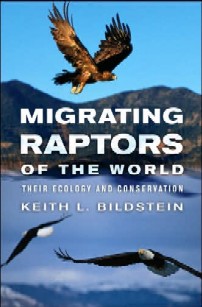Reviewed by Grant McCreary on February 24th, 2007.
When I think of migrating raptors the first thing that comes to mind is Broad-winged Hawks. Every fall they leave their breeding grounds in eastern and central North America and travel south through Mexico to their wintering grounds in Central and South America. And when spring comes they head back. One of the most amazing sites I have ever seen is thousands upon thousands of these hawks in the air above Santa Ana National Wildlife Refuge in south Texas. But even that does not compare to Veracruz, Mexico. There geography forces the migrating hawks into a narrow corridor. Just about the entire world’s population of Broad-winged and Swainson’s Hawks fly over this site every fall, earning it the designation Veracruz “river-of-raptors”. This book gives insight into this wondrous phenomenon of raptor migration, the birds that practice it, and the dangers they face.
Just about every possible aspect of this subject is covered including the likely origins of raptor migration, a history of hawk migration studies, flight strategies, ecology, geography, and conservation.
The author also presents a detailed description of the migratory behavior of eight birds: Turkey Vulture; Osprey; Bald Eagle; Western Honey Buzzard; Northern Harrier; Grey-faced Buzzard; Steppe Buzzard; and Amur Falcon. The intent is to show the remarkable diversification in migratory raptors. These accounts are very detailed and comprehensive yet still enjoyable and easy to read.
Additionally, there is a brief overview of twelve great hawkwatch sites: Hawk Mountain, Pennsylvania; Cape May Point, New Jersey; Hawk Ridge, Minnesota; Corpus Christi, Texas; Grassy Key, Florida; Golden Gate Raptor Observatory, California; Kekoldi Indigenous Reserve, Costa Rica; Veracruz, Mexico; Falsterbo Bird Observatory, Sweden; Organbidexka Col Libre, France; Strait of Gibraltar, Spain; and Elat, Israel. The site and its history are described, as well as the hawks you can expect to see there.
The text has just the right tone. It is scientific and informative, yet readily understandable and not dry. As an added help some terms that may not be familiar are italicized and defined in the glossary.
Eight pages of color photographs that illustrate various points made throughout the text are bundled together in the middle of the book. A few of the pictures are the standard ones that are expected such as a Sharp-shinned Hawk on a bird feeder, or a large group of migrating vultures. But most of them are unique and very interesting. There’s a Black Kite being harassed by a gull while it’s trying to cross the Strait of Gibraltar. Also shown is a Booted Eagle drying off on the ground after some gulls had driven it into the surf, also at Gibraltar. And showing how things have changed are two 1930’s posters from the Pennsylvania Game Commission urging hunters to “know your birds” and “don’t shoot protected hawks”.
According to the author the purpose of this book is to provide “an up-to-date balanced overview of the principal aspects of raptor-migration science and conservation, together with a detailed global geography of the phenomenon.” This book aptly accomplishes this goal and is recommended to all raptor enthusiasts and all who want to learn more about these majestic creatures and their marvelous journeys.
Disclosure: I get a small commission for purchases made through links in this post.



Harrier…
Your topic Review: Migrating Raptors of the World: Their Ecology and … was interesting….